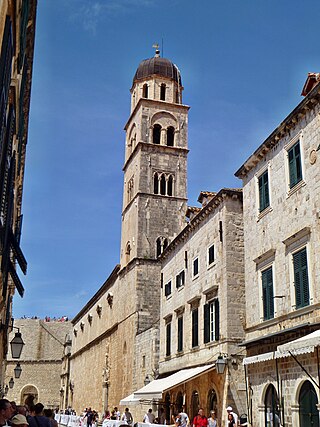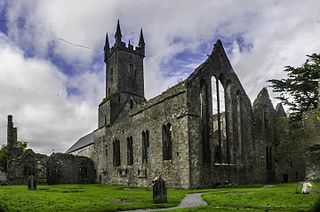
The Order of Friars Minor Capuchin is a religious order of Franciscan friars within the Catholic Church, one of Three "First Orders" that reformed from the Franciscan Friars Minor Observant, the other being the Conventuals. Franciscans reformed as Capuchins in 1525 with the purpose of regaining the original Habit (Tunic) of St. Francis of Assisi and also for returning to a stricter observance of the rule established by Francis of Assisi in 1209.

Benedict the Moor was a Sicilian Franciscan friar who is venerated as a saint in the Catholic church. Born of enslaved Africans in San Fratello, he was freed at birth and became known for his charity. As a young man he joined a Franciscan-affiliated hermit group, of which he became the leader. In 1564 he was sent to the Franciscan friary in Palermo, where he continued good works.

The Buttevant Franciscan Friary is a ruined 13th-century Franciscan friary is situated in the middle of the town of Buttevant, County Cork, Ireland. The Augustinian friary in nearby Ballybeg is often confused with the Buttevant Franciscan Friary in historical documents.

The Church and Friary of St Francis, known locally as Gorton Monastery, is a Grade II* listed former Franciscan friary in Gorton, Manchester, England. It was designed by the noted Victorian architect Edward Welby Pugin and built 1866–1872. Gorton Monastery is a noted example of Gothic Revival architecture.

All Saints' Church is a Roman Catholic parish church situated between Dumplington and Barton upon Irwell, near Urmston, in Trafford, Greater Manchester, England. The church was constructed between 1867 and 1868 and was designed by E. W. Pugin in the Gothic Revival style for Sir Humphrey de Trafford. It is situated on Redclyffe Road, close to the Manchester Ship Canal. The church is a Grade I listed building and considered to be an example of Pugin's best work, according to Nikolaus Pevsner, "the masterpiece of [Pugin's] life, without any doubt." It has been served by priests from the Conventual Franciscans since 1928.

John Forest was an English Franciscan friar and martyr. Confessor to Queen Catherine of Aragon, Forest was burned to death at Smithfield for heresy, in that he refused to acknowledge the King as head of the church.

In the United Kingdom, the term listed building refers to a building or other structure officially designated as being of special architectural, historical, or cultural significance; Grade II* structures are those considered to be "particularly important buildings of more than special interest". Listing was begun by a provision in the Town and Country Planning Act 1947. Once listed, strict limitations are imposed on the modifications allowed to a building's structure or fittings. In Wales, the authority for listing under the Planning Act 1990 rests with Cadw.

St Augustine's Abbey or Chilworth Abbey, formerly Chilworth Friary, is a Roman Catholic Benedictine abbey in Chilworth, Surrey. The building, which is Grade II listed, was designed by Frederick Walters and was built in 1892. It was formerly a Franciscan friary and a novitiate for the order. The abbey church is open to the public 365 days a year.

The Franciscan friary and church is a large complex belonging to the Order of the Friars Minor. It consists of a friary, a church, a library, and a pharmacy. It is situated at the Placa, the main street of Dubrovnik, Croatia.

Ennis Friary was a Franciscan friary in the town of Ennis, County Clare, Ireland. It was established in the middle of the 13th century by the ruling O'Brien dynasty who supported it for most of its existence. Following the suppression of the monasteries in the 16th century, the friary continued to function for a while despite the loss of its lands. In the early 17th century, the buildings were handed over to the Church of Ireland as a place of worship. It was used as such until the late 19th century. After the construction of a new Church of Ireland building, the friary fell into ruin. Managed by the Office of Public Works since the late 19th century, it was formally returned to the Franciscan Order in 1969.

Immaculate Conception Church also known as the Church of the Immaculate Conception of Mary is a Roman Catholic parish church in Clevedon, Somerset. It was built from 1886 to 1887 and was designed by Alexander Scoles, an architect and priest who worked in Somerset. It is located on the intersection between Marine Parade, Marine Hill and Wellington Terrace, overlooking the Severn Estuary. It was founded by the Franciscan Order of Friars Minor who continue to serve the parish.

The Friary, formally known as Blessed Agnellus of Pisa Friary, formerly All Saints Convent or St John's Home is a centre of formation for the Franciscan Order of Friars Minor Conventual in Cowley, Oxford, England. The building was constructed in 1873 as the convent of the Anglican Society of All Saints Sisters of the Poor. It is situated between St Mary's Road and Cowley Road, next to St John's Care Home and Helen & Douglas House. The friary and its chapel are Grade II listed buildings.

St Francis of Assisi Church is a Roman Catholic parish church in Stratford, London. It was founded from a mission that started in 1770. The church itself was built in 1868. The church is located on the corner of Grove Crescent Road and The Grove, and is accessible from both streets. The Franciscan Order of Friars Minor arrived in 1873, built a friary next door to the church in 1876 and continue to serve the parish.





















